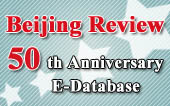| Since 2006, amid explosive growth of auto sales, congestion has become a headache for Chinese cities, big and small. Now, it's common that many downtown streets, especially in developed eastern and central regions, are clogged by endless fleets of cars at rush hour.
Last December, Beijing, allegedly suffering the worst traffic woes in China, put into practice a package of measures to try to ameliorate the situation, focusing on curbing car sales and encouraging the use of public transport.
In January, the municipal government of Guangzhou, the largest business hub in Guangdong Province and also the whole of south China, proposed 30 traffic improvement measures for public feedback, including charging a congestion fee.
Unfortunately, these efforts have not received widespread public support.
There are multiple avenues of blame for the worsening urban traffic load in China, but short sightedness in infrastructure construction and management is the primary issue.
For a long time, Chinese cities grew around a single center where most residents worked and where first-class educational, medical, entertainment and other public resources were located. As a greater number of residents now live far from city centers due to rapid urban expansion, the soaring commuter flows have added great pressure to still underdeveloped public transit systems. When demand cannot be satisfied, people turn to private cars. But, as a result of poorly designed urban road networks, many trunk and link road junctures have become bottlenecks.
Despite this, rail systems, widely known as the most effective public transportation solution, were not put higher on local authorities' priority lists until traffic flows had already become too heavy.
Traffic congestion in Chinese cities is a reflection of poor administration more than excessive automobile ownership. Technical measures and financial input are far from enough to cure this urban disease.
The current problematic traffic situation has arisen from administrators' neglect of the rules of city development and residents' needs in their decision-making processes. They must make residents' convenience and comfort the ultimate goal of new policies and mobilize all residents to take part in the building of a harmonious environment for man and environment.
More importantly, to convince the public, policies and efforts related to traffic problems must be systematic and continual. Only when residents are confident that they will have an improved traffic situation, will they be willing to cede temporarily a portion of their personal rights to remedy public order. | 